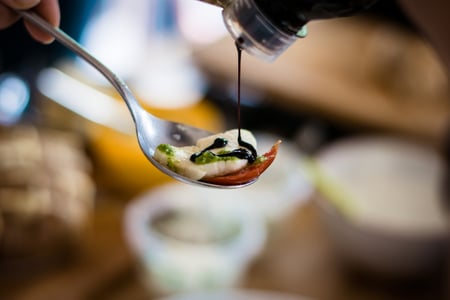For foodies balsamic vinegar is a must-have. This rich, mildly sour, slightly sweet and distinctly flavorful vinegar is a versatile pantry staple. But what you have in your pantry is likely not the real deal balsamic vinegar. Grocery and even specialty stores in the rest of the world sell a replica, aged often less than three months and infused with preservatives. As you’ll find out this is far from the method used to produce real balsamic vinegar.
The History Behind Prized Aceto Balsamico
To understand the distinction of true Aceto Balsamico, you must first learn the history of Italy’s dark liquid gold. Authentic balsamic vinegar of Italy comes from the Modena or Reggio-Emilia regions. The first known appearance of Aceto Balsamico dates back to 1046 when a bottle of this tasty treasure was given to the emperor as a highly regarded gift.
In the Middle Ages Aceto Balsamico was valued for its disinfectant properties. This luscious liquid is celebrated as a miracle cure for everything from easing the pain of a sore throat to minimizing the pains of labor. Balsamic vinegar is so prized that when a daughter was born into a family the mother would begin the long process of making the vinegar to enrich her dowry when she married.
You won’t find true Aceto Balsamico for $4.99 at your favorite grocery store. And once you’ve experienced the real deal, you’ll never let those mass-produced imposters pass your lips again-at least not knowingly. Aceto Balsamico is recognized as a DOP, or Denominazione di Origine Protetta, food of Italy. The food product is protected because of its designation of origin. DOP is a distinction given specific food products due to the place of origin and characteristics of the production process from that specific geographical location.
The Fine Art of Making Balsamic Vinegar
Balsamic vinegar is created from a reduction of sweet white grapes, Trebbiano and Spergola. The grape juices are put into a copper cauldron and cooked slowly over an open flame until the liquid is reduced by half. The resulting must is then aged by placing it into a wooden barrel and combining the grape must with an acetic older balsamic vinegar.
Each year the contents will be transferred to another barrel, made for a different wood, so the flavors or the wood will infuse. There are only a few acceptable barrel wood types that can be used to create authentic Aceto Balsamico. The approved woods are oak, cherry, chestnut, mulberry, acacia, juniper, and ash.
Balsamic vinegar is aged for a minimum of 3 years. The worth of this dark liquid gold reflects its age. Three years to five years is considered young, six to 12 years is middle aged and 12 years up to 150 years is considered highly prized and very old. Of course, in Italy, the average balsamic vinegar is about 25 years old with a sweet syrup-like texture and intense flavor.
The creation of Aceto Balsamico is a family affair and the different barrels are often passed down through multiple generations. The commitment to creating the vinegar is a dedicated and elaborate ritual. It is necessary that balsamic vinegar be fed regularly with aged “mother” vinegar. The end product is the result of many years of mixing the right vinegars at the right time to achieve the perfect batch.
A Flavorful Investment
Given its labor-intensive production Italy’s Aceto Balsamico is not inexpensive. But how do you put a price on such a priceless treasure? Of course once your palate experiences this taste of heaven you will long to obtain your own bottle of this dark liquid gold at any cost.
Unlike the grocery store replica, true Aceto Balsamico is used sparingly, not only because of its worth but also the rich flavor requires not much more than a drizzle or two. This condimento ideally complements cured and roasted meats, fresh vegetables, fruit, cheeses and even gelato.

Share this article
-
Share on Facebook
Share on Facebook
-
Share on Twitter
Share on Twitter
-
Share on WhatsApp
Share on WhatsApp
-
Share on Pinterest
Share on Pinterest
-
Share on LinkedIn
Share on LinkedIn
-
Share on Tumblr
Share on Tumblr
-
Share on Vk
Share on Vk
-
Share on Reddit
Share on Reddit
-
Share by Mail
Share by Mail


